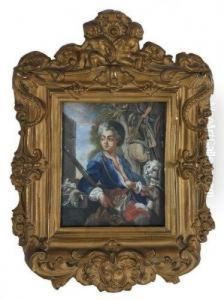Robert Mussard Paintings
Robert Mussard was a French painter and engraver who lived during the 18th century. He was born in 1713 in Paris, France, into a family with artistic connections; his brother, Pierre-Antoine Mussard, was also a painter. Robert Mussard is less well-known today and remains a relatively obscure figure in art history, overshadowed by the prominent artists of his time, such as François Boucher and Jean-Honoré Fragonard.
Mussard's career unfolded in an era when the Rococo style was flourishing in France. This period was characterized by elaborate ornamentation, pastel colors, and playful themes. However, Mussard did not achieve the same level of fame or success as the leading Rococo artists. His work primarily consisted of engravings and genre paintings, which depicted scenes of everyday life with an emphasis on the depiction of the costumes of his time.
Interestingly, Mussard is perhaps better remembered for his connection to the early development of the panorama painting. His nephew, Pierre Prévost, is credited with creating one of the first panoramas, which were large-scale, 360-degree paintings designed to immerse viewers in a particular scene. It is believed that Mussard may have influenced his nephew's work or at least provided an artistic environment that nurtured Prévost's interest in such visual experiments.
Robert Mussard's contributions to the art world were modest, and his works rarely come up for auction or are displayed in major museums. As such, detailed information about his life, artistic training, and oeuvre is limited. He passed away in 1777 in Paris, having lived through a dynamic period in French art history but without having made a significant impact on the course of art himself. Despite this, his life and work offer a glimpse into the broader tapestry of French artistic production during the 18th century.
